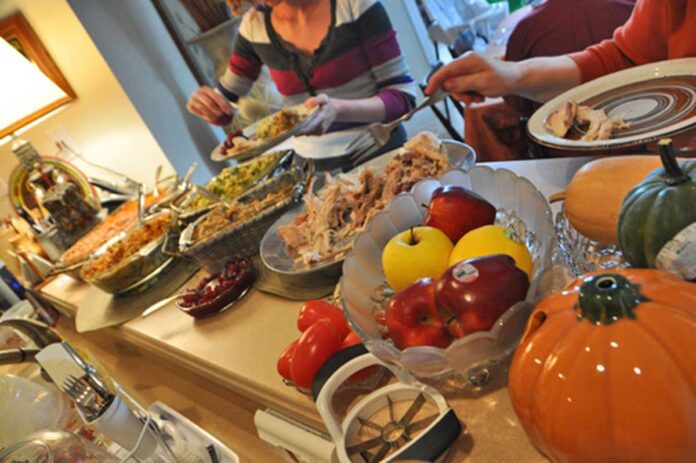If you are reading this, you already have a reason to give thanks: You have (thus far) survived the coronavirus pandemic that has killed more than a quarter million Americans.
This is where we are, ten months into the worst global pandemic in a century: gratitude for survival. Back on February 7, President Trump confided in Washington Post associate editor Bob Woodward that he knew the coronavirus was deadly — far deadlier than the flu.
Yet on March 19, in another recorded interview with Woodward, Trump said he was dedicated to downplaying the virus. He told Woodward that he didn’t want to cause a panic or disrupt the stock market.
On February 7 there were fewer than 100 cases and no deaths in the U.S. On March 19 there were fewer than 2,000 cases and 38 deaths. Now, as the holidays loom, there have been two million new cases in ten days and someone dies of COVID-19 every minute in America. In El Paso, prisoners in full PPE are loading bodies onto refrigerated trucks for $2 an hour. In Brooklyn, 600 bodies lie unclaimed because their relatives have also died.
And that is just a snapshot.
If you are lucky, no one you know has died. If you are lucky, you haven’t gotten sick. For those of us who watched people we loved die during the AIDS pandemic in the 1980s and 1990s, these past months have brought back terrible memories.
In the AIDS pandemic, I lost a dozen friends one year. They died horribly. They died alone. One died on the floor of his apartment over Christmas and wasn’t found for days. I will never get that image out of my head.
I never thought I would see anything as terrible again as those years when I was alternately reporting on the pandemic and getting arrested in die-ins with ACT UP and other groups. Yet here we are. Even now, with only several more weeks of his presidency, there are things Trump could do to save lives. But he won’t.
And so we are left, as we were in those AIDS plague years, to do it all ourselves.
This will be a lonely holiday season for many of us. And a dangerous one. Dr. Anthony Fauci — a face from our AIDS pandemic years — has said we can’t get together this year with people outside our bubble: the risk of contracting the virus is too great. But there are other concerns raised by the pandemic. Unemployment, poverty, hunger.
Before the coronavirus hit, Philadelphia was the poorest big city in America. It is even more poor now. And so is the LGBTQ community.
While poverty rates had decreased in the nation overall pre-pandemic, Philly got more poor, with 26 percent — more than 400,000 Philadelphians — living in poverty and 36.4 percent earning $25,000 or less. A disproportionate number of those people are LGBTQ.
Philadelphia also has the highest rate of people living in “deep poverty” — with earnings of less than 50 percent of the $16,643 federal-poverty level. More than 12 percent — nearly 200,000 Philadelphians — live in deep poverty.
Not much to give thanks for this holiday.
In 2019 I won a Society of Professional Journalists Keystone Award for my 2018 series on LGBTQ poverty in Philadelphia. I interviewed a dozen poor LGBTQ people ranging in age from their 20s to their 70s.
Since then I have reported a dozen more pieces on LGBTQ poverty, including two pieces for PGN in just the past month. The Movement Advancement Project, HRC, the Center for American Progress and The Williams Institute have all issued reports on the disproportionate levels of poverty among LGBTQ people, particularly people of color. Philadelphia is nearly 70 percent Black, Latinx and Asian/PI.
The math is grim.
Food insecurity is part of poverty and it is rife in the LGBTQ community. The U.S. Department of Agriculture (USDA) defines food insecurity as a “lack of consistent access to adequate food for an active, healthy life.”
Nearly two million Pennsylvanians are food insecure, according to Feeding America. Turn on CNN or your local news and the lines for food banks locally and nationally are huge due to the pandemic.
Recent studies from LGBT Funders and Move for Hunger reveal that LGBTQ people are six times more likely than non-LGBTQ people to lack enough money for food for themselves or their families at some point in the last year. Black LGBTQ people are twice as likely as their white peers to be food insecure. LBTQ women are more likely to be food insecure than their male counterparts.
According to the Philadelphia Hunger Report for 2018, the last year for which there are data, the number of people struggling against hunger in Philadelphia increased by 22 percent just since 2014. That data showed a quarter-million adults in the Philadelphia metropolitan region were working from 2015- 2017, yet were still food insecure. One in four Philadelphians and one in six Pennsylvanians is food insecure.
A lesbian friend who works at a local food bank told me “There’s shame attached to being food insecure. Getting people to reveal their circumstances, that is part of it. You have to help people get to the food.”
She said, “Be aware that people you know may be quietly starving.”
The season of giving launches on Thanksgiving, but with the pandemic shutting down access to everything, how are poor and homeless LGBTQ people getting help? In this pandemic year, when so many of us are unemployed, furloughed or under-employed, what will happen to the most vulnerable members of our community?
As the pandemic rages on, it is a question with no answers.If you are currently out of work and/or food insecure, the City of Philadelphia has an emergency cash assistance program. You can apply at www.compass.state.pa.us. Benephilly helps low-income Philadelphians access services: 1-844-848-4376. Manna provides meals for people with HIV/AIDS and other chronic illnesses. Apply at www.mannapa.org.
